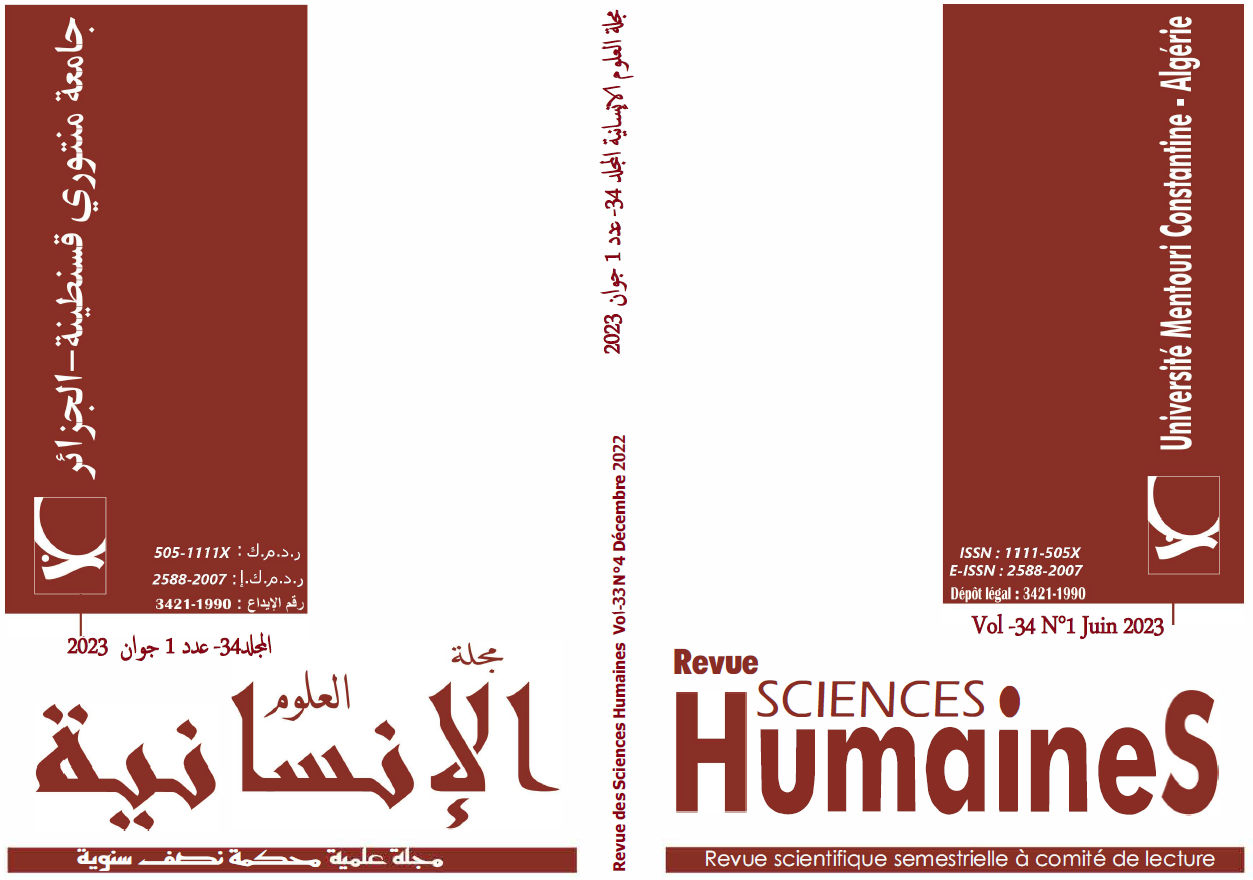Examining the Implementation of Different Test Tasks in Assessing EFL Learners’ Use of English Tenses
Mots-clés :
les temps en anglais, évaluation de la grammaire, remplissage des espaces, choix multiples, jugement de grammaticalitéRésumé
Cette étude examine comment différentes activités évaluent l'utilisation des temps anglais par les apprenants. Les enseignants d’anglais utilisent des activités telles que le remplissage des espaces, les choix multiples et le jugement de grammaticalité. Pour évaluer comment ces types d’activités évaluent l'utilisation des temps, 3 tests sur les temps présent, passé et futur -chacun incluant les 3 activités- sont administrés à 29 apprenants d’anglais de deuxième année à l’ENS Assia Djebar, Constantine, Algérie. Les résultats révèlent que les scores élevés sont dans l’activité à choix multiples et les bas sont dans celle de jugement de grammaticalité, et que les scores dans l’activité à choix multiples ne reflètent pas la maîtrise des usages des temps anglais vu le manque de correspondance entre tous les scores obtenus. Les résultats montrent que l'évaluation des usages des temps doit inclure différentes activités pour une vision complète des connaissances des temps en anglais par les apprenants.
Téléchargements
Références
. Andrews, S. (2007). Teacher language awareness. Cambridge, UK: Cambridge University Press.
. Broughton, G., Brumfit, C., Flavell, R., Hill, P., & Pincas, A. (1980). Teaching English as a foreign language (2nd ed.). New York: Routledge.
. Canale, M. A. & Swain, M. (1980). Theoretical bases of communicative approaches of second language teaching and testing. Applied Linguistics (1). pp 1-47.
. Comrie, B. (1985). Tense. Cambridge: CUP.
. Cowan, R. (2008). The teacher’s grammar of English. Cambridge: CUP.
. Ellis, R. (1995). Interpretation tasks for grammar teaching. TESOL Quarterly 29(1), 87-105.
. Ellis, R. (2004) The definition and measurement of explicit knowledge. Language Learning 54, 227-275.
. Ellis, R. (2006). Current issues in the teaching of grammar: An SLA perspective. TESOL Quarterly 40(1), 83-107.
. Ellis, R. (2009). Implicit and explicit learning, knowledge and instruction. In R. Ellis, S. Loewen, C. Elder, R. Erlam, J. Philp and H. Reinders (Eds.) Implicit and Explicit Knowledge in Second Language Learning, Testing and Teaching (pp. 3-26). Bristol, UK: Multilingual Matters.
. Gebhard, M. & Martin, J. R. (2011). Grammar and literacy learning. In Diane Lapp and Douglas Fisher (Eds.), Handbook of research on teaching English language arts (3rd Edition), pp.297-304. NY: Routledge.
. Hinkel, E & Fotos, S. (2002). From theory to practice: A teacher’s view. In E. Hinkel and S. Fotos (Eds.), New Perspectives on Grammar Teaching Second Language Classrooms (1-12). Mahwah, NJ: Lawrence Erlbaum Associates.
. Kennedy, G. (2003). Structure and meaning in English: A guide for teachers. Harlow, England: Pearson Education Limited.
. Klapper, J. (2005). Teaching Grammar. In J. A. Coleman, & J. Klapper (Eds.), Effective Learning and Teaching in Modern Languages (pp. 67-74). Abingdon, Oxon, UK: Routledge.
. Klein, S. (2003). Language and Diversity. In Irene L. Clark (Ed.), Concepts in composition: theory and practice in the teaching of writing (pp. 413-480). Mahwah, New Jersey: Lawrence Erlbaum Associates.
. Krashen, S. D. (1982). Principles and practice in second language acquisition (First Internet ed.). Pergamon Press Inc.
. Larsen-Freeman, D. (2009). Teaching and testing grammar. In M. H. Long & C. J. Doughty, The Handbook of Language Teaching (pp. 518-542). Oxford, UK: Wiley-Blackwell.
. Loewen, S. (2009). Grammaticality judgement tests and the measurement of implicit and explicit L2 knowledge. In R. Ellis, S. Loewen, C. Elder, R. Erlam, J. Philp and H. Reinders (Eds.) Implicit and Explicit Knowledge in Second Language Learning, Testing and Teaching (pp. 94-112). Bristol, UK: Multilingual Matters.
. McKay, P. (2006). Assessing young language learners. Cambridge, UK: Cambridge University Press.
. Nilson, L. B. (2010). Teaching at its best: a research-based resource for college instructors (3rd Ed.). San Fransicso, CA: Jossey-Bass.
. Oller, J. W. Jr. & Jonz, J. (1994). Why cloze procure. In Oller and Jonz (Eds.), Cloze and Coherence, pp.1-20. Cranbury, NJ: Bucknell University Press.
. Pachler, N & Field, K. (2001). Learning to teach modern foreign languages in the secondary school: A companion to school experience. London: Routledge Falmer.
. Pierce, L. V. (2002). Performance-based assessment: Promoting achievement for English language learners. ERIC/CLL News Bulletin, 26(1), 2–7.
. Purpura, J. (2004). Assessing Grammar. Cambridge, UK: Cambridge University Press.
. Richards, J. C. & Reppen, R. (2014). Towards a pedagogy of grammar instruction. RELC Journal45(1), 5-25.
. Richards, J. C. & Schmidt, R. (2010). Longman Dictionary of Language Teaching & Applied Linguistics (4th Edition). Harlow, England: Pearson Education Limited.
. Richards, J. C. (2006). Communicative language teaching today. New York: Cambridge University Press.
. Taylor, J. R. (2008). Some pedagogical implications of cognitive linguistics. In S. De Knop and T. De Rycker (Eds.), Cognitive Approaches to Pedagogical Grammar (pp.37-65). Berlin, Germany: Mouton De Gruyter.
Téléchargements
Publié
Numéro
Rubrique
Licence
© Revue des Sciences Humaines 2023

Cette œuvre est sous licence Creative Commons Attribution - Pas d'Utilisation Commerciale - Pas de Modification 4.0 International.












